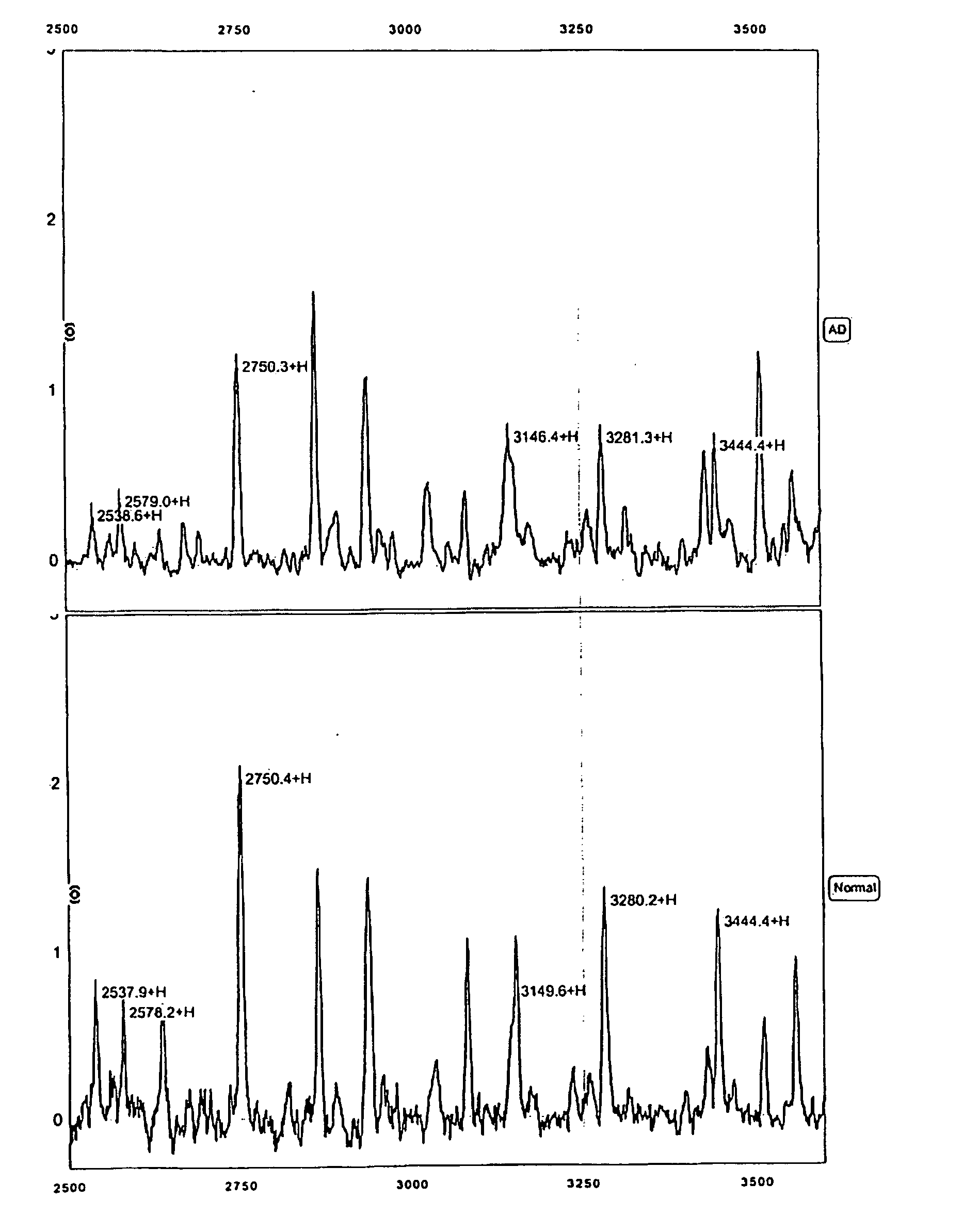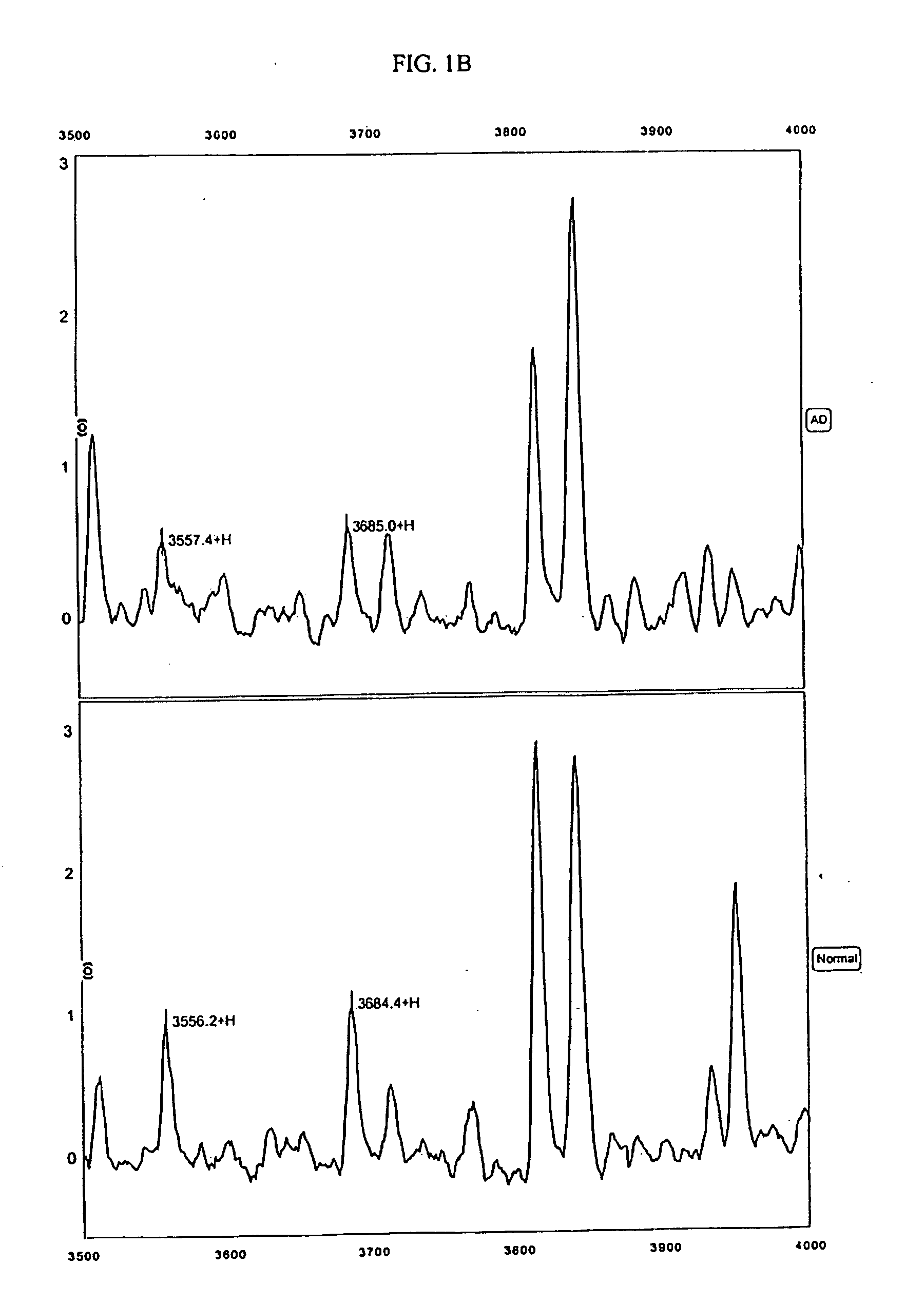Biomarkers for Alzheimer's disease
a biomarker and alzheimer's disease technology, applied in the field of progressive neurodegenerative disorders, can solve the problems of limiting their widespread adoption into clinical practice, csf from ad patients' ttr, and unable to achieve the definition of brain disease only through post-mortem brain examination
- Summary
- Abstract
- Description
- Claims
- Application Information
AI Technical Summary
Benefits of technology
Problems solved by technology
Method used
Image
Examples
example 1
Discovery of Biomarkers for Alzheimer's Disease
[0164] The protocols described in the Example below were used to generate mass spectra from 65 Swedish patient samples, 30 of whom were diagnosed with Alzheimer's disease and 35 of whom did not exhibit dementia. For this study, patients were diagnosed as AD patients according to NINCDS-ADRDA criteria, which includes cognitive testing, routine blood and urine tests, MRI or CT imaging when applicable, and measurements of CSF Tau and A-Beta(42). Severity of dementia assessed using Mini Mental State Examination (MMSE). The 30 Alzheimer's samples were taken from patients with an average MMSE of 21 (range from 5 to 30). The 35 control patients were age-matched, with a mean MMSE of 29 (range from 25-30). MMSE scores greater than 18 are considered evidence of mild dementia and patients with MMSE scores greater than 24 are considered to be extremely mild cases.
[0165] 1. Anion Exchange Fractionation
[0166] Buffer List for anion exchange fractio...
example 2
Validation Study of B2 Microglobulin as a Marker for Alzheimer's Disease
[0299] To validate the use of β2 microglobulin as a marker for Alzheimer's disease, 158 cerebrosprinal fluid (CSF) samples were taken from pre-diagnosed subjects in three groups: (1) Alzheimer's disease (AD), (2) Control, and (3) non-Alzheimer's dementia (Non AD). The distribution of samples in these groups is shown in Table III, below.
TABLE IIIDistribution of Subjects in β2 Microglobulin Validation StudySubject Classification# of SubjectsAlzheimer's DiseaseAD Mild (MMSE > 24)56AD severe10ControlDepression6Control45Non-Alzheimer's DementiaFTD21LBD20Total158
[0300] Briefly, of the 158 samples, sixty six were taken from patients suffering from mild forms of Alzheimer's disease (characterized by a Mini-Mental State Examination (MMSE) score greater than twenty four) or suffering from more severe forms of Alzheimer's disease. Fifty one “control” samples were obtained from non-dementia patients, including six patien...
example 3
Discovery of Additional Biomakers for Alzheimer's Disease
[0324] For this Example, 237 CSF samples from Swedish and Finnish patients were used. These samples included: 98 samples from patients with Alzheimer's Disease (including 83 very mild cases with MMSE>24), 31 samples from patients with Frontotemporal Dementia (FTD), 29 samples from patients with dementia with Lewy Body (DLB), and 79 age-matched normal individuals including 9 depression controls. Diagnoses were made according to the NINCDS-ADRDA criteria discussed in the preceding Examples. The 237 samples were randomly divided into sets for training (⅔) and blind testing (⅓).
[0325] The anion exchange prefractionation step utilized in Example 1, above, was omitted for these CSF samples (note that for serum samples, the use of a pre-fractionation step is preferred). Instead, 5 μL of neat CSF sample was used per well on each chip. The chips used were Ciphergen's IMAC30 (activated with copper or nickel), Q10, CM10 and H50 Protein...
PUM
 Login to View More
Login to View More Abstract
Description
Claims
Application Information
 Login to View More
Login to View More - R&D
- Intellectual Property
- Life Sciences
- Materials
- Tech Scout
- Unparalleled Data Quality
- Higher Quality Content
- 60% Fewer Hallucinations
Browse by: Latest US Patents, China's latest patents, Technical Efficacy Thesaurus, Application Domain, Technology Topic, Popular Technical Reports.
© 2025 PatSnap. All rights reserved.Legal|Privacy policy|Modern Slavery Act Transparency Statement|Sitemap|About US| Contact US: help@patsnap.com



